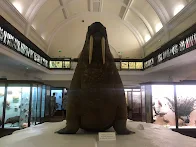Advanced apology for the poor formatting of this blogpost.
cue intro...
 When people visit London, they're most likely looking forward to
seeing Big Ben, Tower Bridge, Buckingham Palace, the London Eye. You
know, typical tourist-y areas.
When people visit London, they're most likely looking forward to
seeing Big Ben, Tower Bridge, Buckingham Palace, the London Eye. You
know, typical tourist-y areas.
They're less likely to explore South London, however, understandably - there seems to be less to see on this half of the Thames. But with an area of 645.8 km^2, there must be something to see here. So I will occasionally try to visit some of these less thought about areas. Today, it's the turn of a museum...
The Horniman Museum
 The last time I had been in the Horniman Museum was when I was a child, so any memories of the place had largely degraded. I knew it had something to do with biological species and specimens, but other than that, I was clueless.
The last time I had been in the Horniman Museum was when I was a child, so any memories of the place had largely degraded. I knew it had something to do with biological species and specimens, but other than that, I was clueless.
The museum does house that stuff, but it's way more than just a large walrus in the middle of the Natural History gallery. The gallery in question has a host of interesting exhibits all detailing evolution and how various species relate to each other through classification systems and the like. There are models, fossils, taxidermies and remains stored in liquid, with displays on the evolution of horses and Picarian birds and shells. One species I learned about was the interestingly-named common cockle.
 Go one level higher and visit the balcony, with arrays of fossils across various geological ages, as well as a greater focus on various different strands of the Linnaean hierarchy. There's also the Apostle clock nearby which truly looks magnificent.
Go one level higher and visit the balcony, with arrays of fossils across various geological ages, as well as a greater focus on various different strands of the Linnaean hierarchy. There's also the Apostle clock nearby which truly looks magnificent.

 The Horniman Museum claims to be the only museum in London to "combine human cultures with the natural world". You can see the various cultures in what they call their "ethnographic collection", with exhibits across all continents. Europe, for example, features Polish, Swedish and English exhibits, whilst Africa covers various people such as the Tuareg and modern Lagos. There is genuinely a lot to see in this part of the museum, so I'll let some photos do the "talking". (Apologies for the lack of variety of photos.)
The Horniman Museum claims to be the only museum in London to "combine human cultures with the natural world". You can see the various cultures in what they call their "ethnographic collection", with exhibits across all continents. Europe, for example, features Polish, Swedish and English exhibits, whilst Africa covers various people such as the Tuareg and modern Lagos. There is genuinely a lot to see in this part of the museum, so I'll let some photos do the "talking". (Apologies for the lack of variety of photos.)

There is also a large music section, featuring various instruments such as this large tuba. You can read about how music is used in Uzbek weddings and Cameroonian funerals, as well as seeing which instruments are used. It is quite fascinating if I can say so myself.
 There's also an aquarium, surrounded by a coral reef display on the ground floor, but that's limited in terms of hours and you need a ticket to enter. Other than the aquarium and certain exhibits (such as the "Brick Dinos" which I saw take place when I visited), everything is free. That includes the gardens, which I didn't visit in much detail.
There's also an aquarium, surrounded by a coral reef display on the ground floor, but that's limited in terms of hours and you need a ticket to enter. Other than the aquarium and certain exhibits (such as the "Brick Dinos" which I saw take place when I visited), everything is free. That includes the gardens, which I didn't visit in much detail.The museum is located in Forest Hill along the South London line on the Overground, with a host of bus routes running nearby, and is located along the South Circular. Obviously the founder of the museum, a certain Frederick John Horniman, didn't want the museum to be here due to its future convenient transport links. So why in Forest Hill?
That's where his family residence used to be. Formerly the Surrey House Museum, he planned to "bring the world to Forest Hill" (his mission in fact!), which he was able to do after taking over his father's tea business, which involved buying tea at cheap prices in China that was grown in exploitative circumstances (as the Horniman Museum's website details). These profits did allow him to travel to places such as the Americas, South Asia and the Far East, where he could then collect items and keep them in Forest Hill. He did this so that those who wouldn't be able to visit these places would be able to see parts of those places' culture themselves.
I do find it rather nice, in retrospect, that this magnificent home of humanity and life in general is situated in what might have once been a quiet, little populated area on the outskirts of London and has now become another commuter area with expensive housing and coffee shops. I wonder what Horniman would have made of it.


Comments
Post a Comment